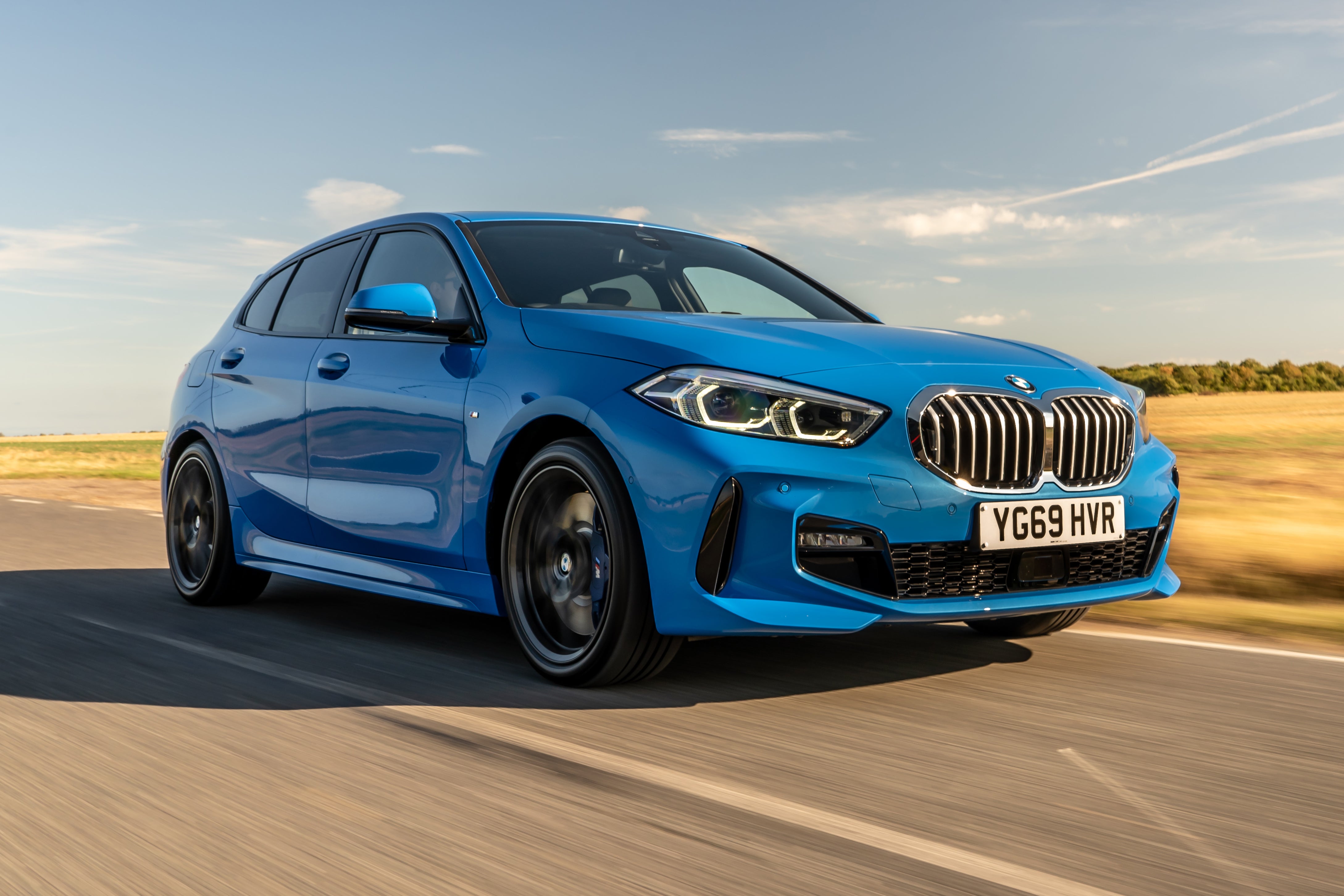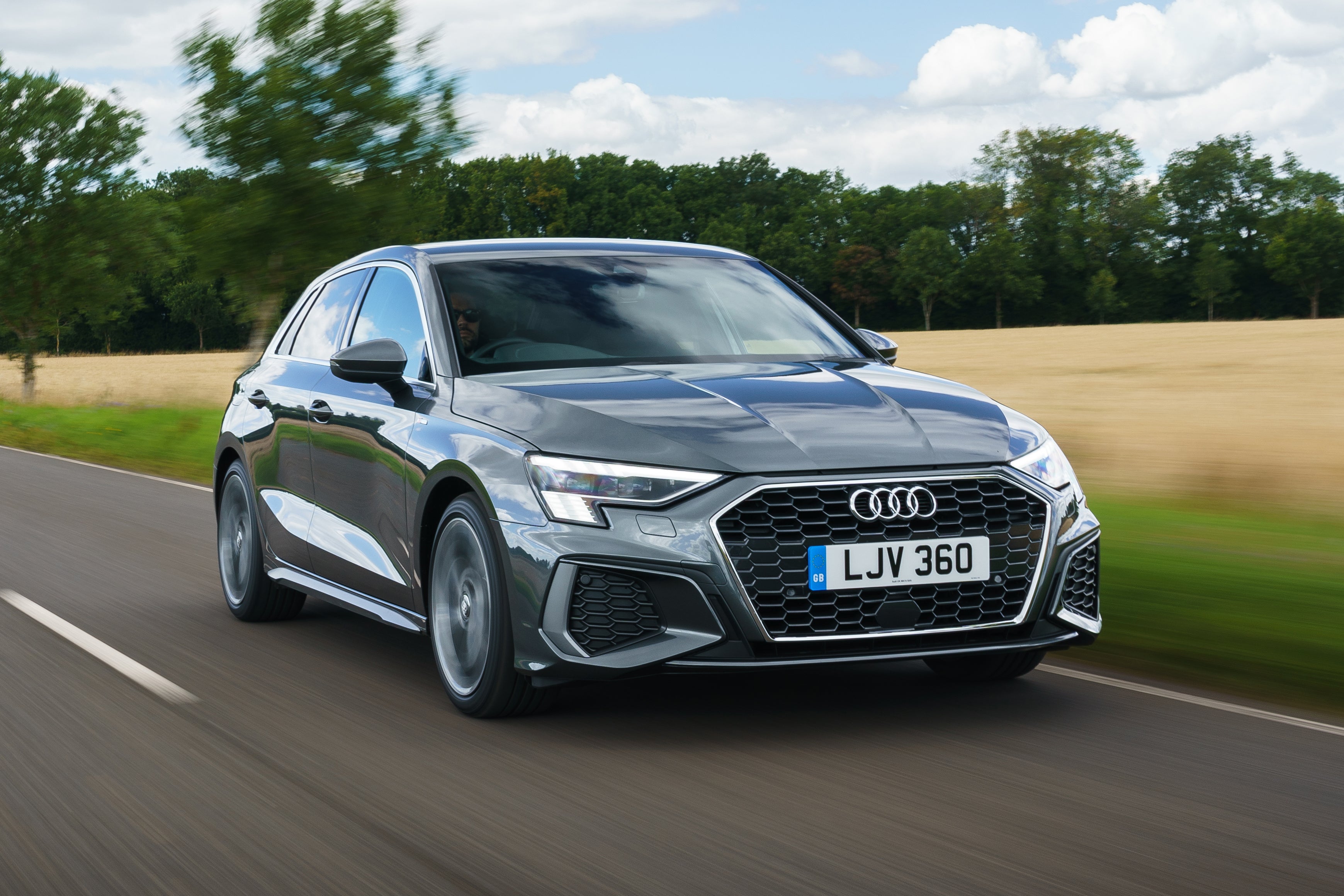Mercedes-Benz A-Class Review 2024
Written by Andy Brady
Quick overview
Pros
- Innovative infotainment system that looks great
- Really posh-looking interior
- Comfortable and secure to drive
Cons
- Merely so-so on practicality
- Petrol engines could be more refined
- Build quality isn't as solid as you'd expect
Overall verdict on the Mercedes-Benz A-Class
"The Mercedes A-Class represents a relatively affordable way of buying a car with that oh-so-desirable three-pointed badge on the front. With frugal engines (now with varying degrees of hybrid power), it ought to be cheap to run, too, while the tech-heavy interior means it certainly doesn't feel like a budget choice. Read all about it in our Mercedes-Benz A-Class review."
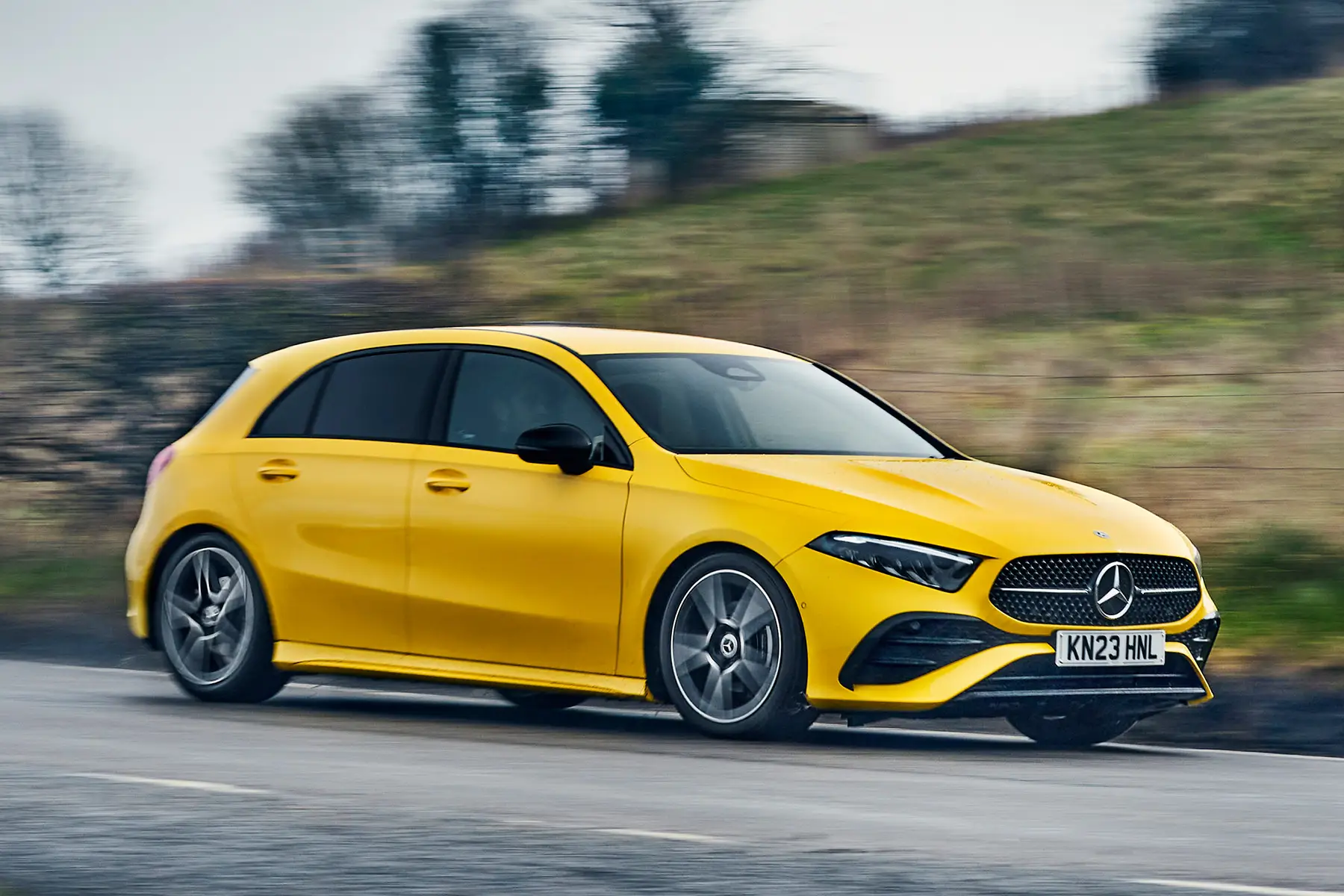
Traditionally, the Mercedes A-Class has been the very embodiment of style over substance. The first-generation car wasn't even that stylish: it was just odd, with MPV-like styling and notoriously poor handling. By the time the third-generation A-Class launched in 2012, it had morphed into a more conventional premium hatchback. While it was a perfectly decent car, it was let down by its poor interior and lacklustre dynamics, and most buyers would have been better off with a mainstream alternative like the Volkswagen Golf.
The latest fourth-generation Mercedes A-Class, however, really moves things along. And that's good news as the competition (namely the Audi A3 and BMW 1 Series) are also better than ever, each providing genuinely upmarket options in the family hatchback class.
For a start, its interior has plenty of wow-factor. It looks really special, even if it doesn't quite have the bulletproof solidity that you might expect from a premium German car. Its big selling point is the dual-screen infotainment setup, which pairs two screens measuring up to 10.25-inches in size. Not only does it look the part, it's also easy to use, helped by the 'hey Mercedes' voice-activated personal assistant.
While the Mercedes A-Class isn't as affordable as it once was (prices for a new one start from around £31,000), it is at least very well equipped for the money. You can drive away in the most basic of models and it won't feel that you've bought a no-frills fleet car. And, as the latest Mercedes A-Class has been on sale since 2018 with only one or two minor updates, you can save cash by buying an example that's a few years old.
There's a wide range of engines to choose from, including petrol, diesel and plug-in hybrid power. The latest petrol models have 48-volt electrical assistance, meaning they're classed as mild hybrids: essentially, an electric motor will give them a small power boost and help recuperate energy, improving fuel economy.
The Mercedes A-Class feels a bit softer than the BMW 1 Series. This may or may not be a good thing, depending on your point of view. We like that it never feels crashy on bumpy roads (even with larger alloy wheels fitted), but some might prefer to drive something a little sportier.
While your money will go further with a Volkswagen Golf or Ford Focus, the Mercedes A-Class is a stylish family hatch with low running costs and an impressive interior. Read our full Mercedes A-Class review to find out if it's the car for you.
Looking for a used car for sale? We've got 100s of Mercedes-Benz Approved Used Cars for Sale for you to choose from, including a wide range of Mercedes A-Class models for sale. If you're looking for the older version, you need our used Mercedes A-Class (2012-2018) review.
Is the Mercedes-Benz A-Class right for you?
If you’ve decided to buy a premium hatchback like the Mercedes-Benz A-Class, then you’ve probably already made the decision - consciously or subconsciously - that a more mainstream alternative like a Ford Focus or a Vauxhall Astra just won’t do.
Once your thought process has come that far, then it’s basically a toss-up between three cars: the Audi A3, the BMW 1 Series and the Mercedes A-Class. So, what does the A-Class give you that the others don’t? Well, the margins are very fine, but there are differences. The Mercedes-Benz A-Class is a slightly more comfortable, more easy-going car than its rivals, while impressive quality and cool design give its interior some serious visual clout. The clever infotainment system will be what seals it for most buyers, though.
What other cars are similar to the Mercedes-Benz A-Class?
Competition between the premium German car brands is fierce. If you're in the market for a Mercedes A-Class, you should also look at the latest Audi A3 and BMW 1 Series.
And then there are mainstream competitors that are edging in on premium territory: sensible hatchbacks like the Volkswagen Golf, for example, and the Mazda 3. Of course, if you're in the market for a desirable family car, we'd also recommend SUVs like the Audi Q3 and BMW X1.
Comfort and design: Mercedes-Benz A-Class interior
"All A-Classes have supportive seats, but the sports seats you get in higher-spec models are especially good."
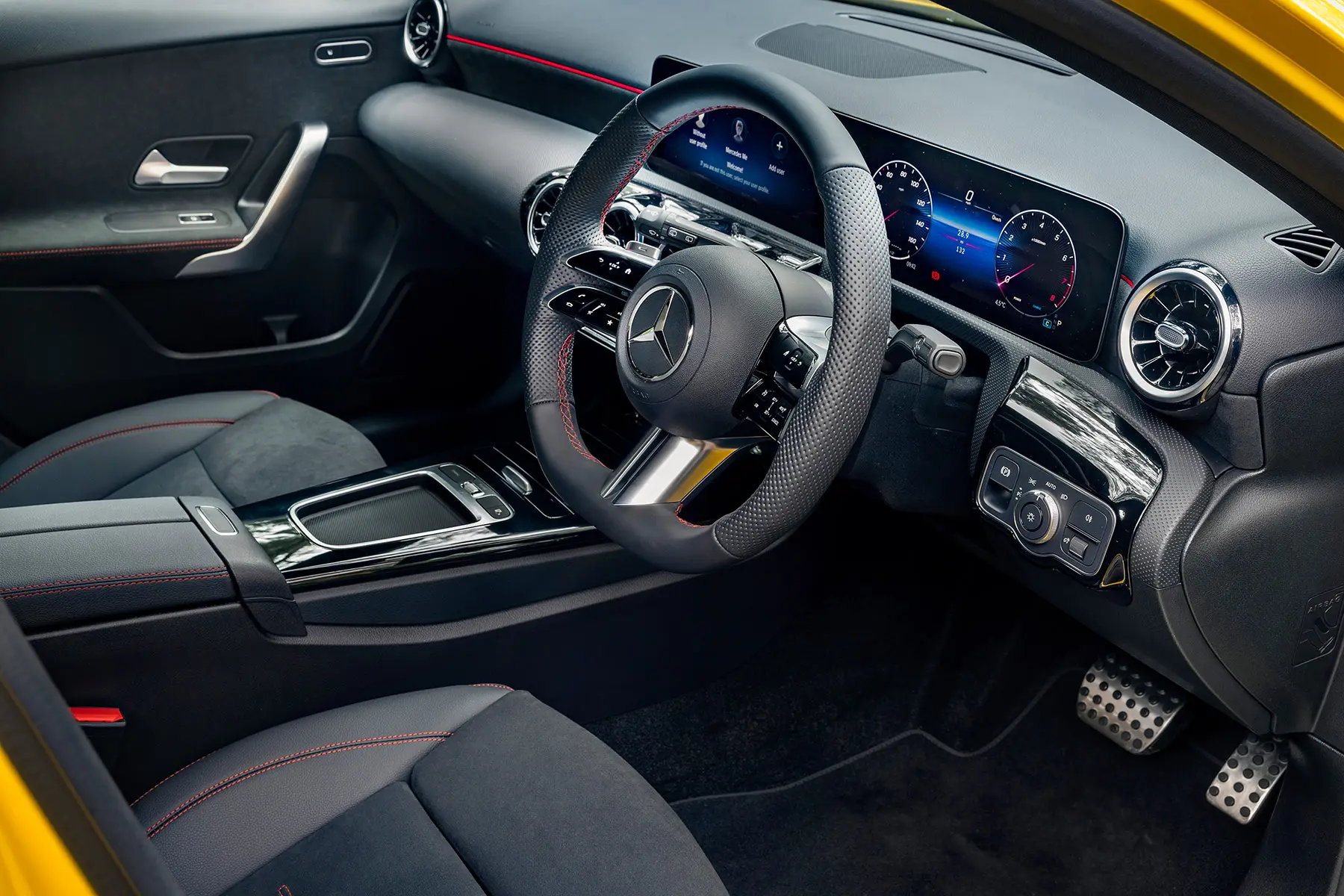
There’s a huge amount of adjustment for the driver’s seat and steering wheel, so drivers of all shapes and sizes should be able to get comfy in the Mercedes A-Class, although some might wish that the seat went a little lower: you feel perched higher up than you do in rivals. That said, this does help give you a clear view of the road ahead, although the view behind you is slightly impaired by the bulky pillars that flank the rear screen. Happily, all versions come with a reversing camera to make parking manoeuvres easier.
The dashboard of the Mercedes A-Class is dominated by the two digital screens that we’ll discuss further in the Infotainment section, but we like the fact that the air-con controls are physical buttons that are separate from the infotainment system. This means you can make minor adjustments without having to scroll through menu after menu and the buttons themselves are logically placed and easy to use. However, the multi-function steering wheel is absolutely covered with various buttons and switches, and the sheer number of them means it’s tricky to remember what everything does.
Quality and finish
This may be the cheapest car that Mercedes-Benz offers, but the A-Class doesn’t feel like a poor relation, not by a long shot. The quality of the materials used makes you feel like you’re in an executive saloon rather than a family hatchback, and importantly, they’re as good as anything else in the class. The twin screens and big, substantial-feeling air vets also help give the interior design plenty of theatre, more so than in rivals, and the various injections of stitched leather, wood, chrome and glossy black panelling means there’s real variety in the colours and textures on show. Aesthetically, then, this really is as good as it gets in the class.
However swish, though, the A-Class’ interior doesn’t feel quite as solid or substantial as rivals from Audi and BMW: pokes and prods in certain places result in a few more creaks and flexes than they do in the other German cars, meaning the Mercedes-Benz doesn’t feel quite as dense or as solid. It really isn’t far behind, though, and you’ll certainly have no reason for complaint.
Infotainment: Touchscreen, USB, nav and stereo in the Mercedes-Benz A-Class
Like all of Mercedes-Benz’s latest cars, the cabin in the A-Class is dominated by two screens that are mounted side-by-side in front of the driver. Known as MBUX, these take care of most of the car’s various functions, plus the information that would usually be delivered on conventional analogue instruments, and presents them all in one integrated unit.
The size of the displays depends on how much you're willing to spend on the A-Class, as well as how new an A-Class you're buying. From 2023, all models come with an impressive pair of 10.25-inch infotainment screens. Earlier cars were offered with a mixture of 7.0- or 10.25-inch displays.
The system is controlled by tapping and swiping at the left-hand screen or, on earlier models (pre-2023), by using the laptop-style touchpad and shortcut buttons located on the central partition between the front seats. Although not quite as user-friendly as the iDrive rotary dial you get in a BMW 1 Series, we liked this system, so it was a shame that it was removed as part of the 2023 A-Class facelift.
You can now perform tasks via the infotainment using touch-sensitive pads on the steering wheel or by triggering the 'hey Mercedes' voice-activated personal assistant. We prefer the latter, although we still find Siri-like systems a bit awkward with passengers in the car.
The augmented-reality navigation, which is fitted to higher-spec Mercedes A-Class models, is worth a mention. This uses the car's cameras to display pictures overlayed with graphics pointing in the direction you need to go. As well as looking pretty cool, it's actually very helpful when you're trying to work out which exit to take on a complicated roundabout or junction.
Space and practicality: Mercedes-Benz A-Class boot space
Whether you wind up sitting in the front or the back of the Mercedes-Benz A-Class, you’ll get a very similar amount of space to that you get in the car’s main rivals from Audi and BMW. There’s virtually nothing to pick between the three here, with each of them providing enough headroom and legroom for tall folk to be comfortable in any of the seats, but without going the extra mile. If you can survive without a premium badge, then less prestigious rivals including the Skoda Octavia and Ford Focus provide more interior space. If you're interested, the Mercedes-Benz A-Class measures 4419mm long and 1796mm wide.
Space aside, though, there are subtle differences. On the plus side, carrying three across the rear bench will be slightly more comfortable in the Mercedes-Benz A-Class due to its lower transmission tunnel, equating to improved rear foot space, while on the negative side, the Benz’s small, oddly shaped rear door openings make getting in and out of the rear seats slightly awkward.
It’s a similar story with the boot. There’s virtually nothing in it for size, and all three cars should cope well enough with the needs of a small family, but there are other small nuances between the three. The A-Class's back seats can be folded 40-20-40 to extend the load area, which is more versatile than the 60-40 split you get in the 1 Series and most A3s. The Mercedes-Benz A-Class has a boot capacity of 370 litres, which is 10 litres less than the Audi A3, while with the seats down that capacity increases to 1210 litres. Again, 10 litres less than the Audi A3.
However, the backrests lie at a slight angle on the Mercedes A-Class, and there’s an annoying lip at the entrance of the boot that you’ll need to lug heavy items over. That’s also the case in the Audi and BMW, but these cars also provide a removable false floor to level the step out, while the Mercedes-Benz A-Class doesn’t. Bear in mind, too, that the PHEV version’s boot loses 60 litres of space due to the batteries.
Handling and ride quality: What is the Mercedes-Benz A-Class like to drive?
"The Mercedes A-Class is one of the more comfortable cars in its class. It takes a slightly softer, more relaxed approach than its direct competitors, and we quite like that."
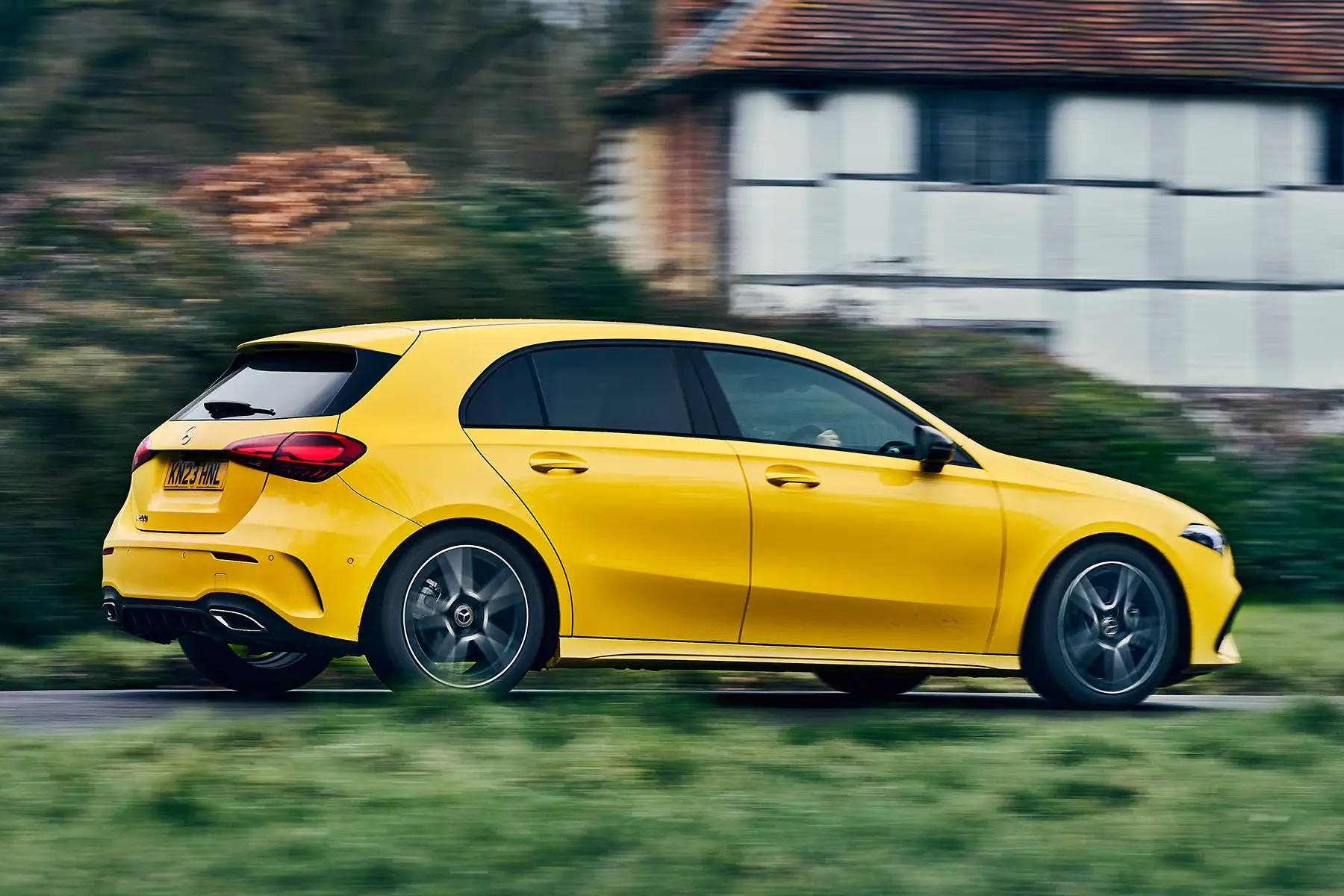
That means the Mercedes A-Class soaks up minor road imperfections a little more effectively, and it doesn’t thud too much over sharp-edged potholes, either, making it one of the more comfortable cars in the class. You will feel the body float a bit more on undulating roads, but not to a degree where you’ll be bouncing around like a Teletubby in a soft-play.
You will feel a bit more body lean in bends in a Mercedes A-Class than you do in Audi A3 and BMW 1 Series, too, so it doesn’t feel quite as sharp or as agile. Having said that, though, the A-Class is no slouch here, either. The body roll is progressive and predictable, so fast direction changes aren’t unsettling, while there’s plenty of grip and precise, accurate steering. True, the steering might be a little light for some tastes, but it does help make life easier when pottering through tight urban environments.
What’s more, we’ve tried the A-Class on a range of different wheel sizes, which can often have a profound effect on how a car rides and handles. But, on the cars we’ve tried, it makes very little difference.
What engines and gearboxes are available in the Mercedes-Benz A-Class?
The A180d was initially a popular option with diesel buyers although it's now been dropped from the range: a reflection on the changing times we live in. Find one on the used market, though, and it'll use a 1.5-litre engine with 116PS. It feels very perky and keen to react initially, which gives it a pleasingly peppy character, but if you really put your foot down, you’ll find that you won’t get quite the level of performance promised by your initial prod of the pedal.
The Mercedes A200d - which is still available - is more responsive. It uses a 2.0-litre turbodiesel engine which produces 150PS and 320Nm of torque, meaning it makes effortless work of joining a motorway or overtaking slow traffic. There was also briefly a more powerful version of this engine, badged the A220d, but this is no longer on sale.
The petrol Mercedes A-Class range kicks off with the A180, which uses a turbocharged 1.3-litre engine that produces 136PS. It'd be a bit harsh to describe the A180 as underpowered, but it certainly needs working hard if you want to get anywhere, so it's not exactly a relaxing experience. For that reason, we'd recommend the A200, which is a 163PS version of the same engine. It's still not rapid, but it requires less effort to get a hustle on.
The quickest Mercedes A-Class (sporty AMG models aside) is the plug-in hybrid, which combines the 1.3-litre petrol engine with an electric motor for a total power output of 218PS. This'll sprint to 62mph in a sprightly 6.6 seconds.
Refinement and noise levels
If you're buying a car with the three-pointed badge on the bonnet, you'd be right to have high expectations when it comes to refinement. But the A-Class isn't all that impressive when it comes to noise levels.
The petrol engines are particularly noisy, especially the A180, which requires working hard to keep up with the flow of traffic. The diesel isn’t the quietest or smoothest engine of its type, but it’s good enough on both counts to keep life civilised enough for even the most demanding of Mercedes A-Class buyers.
You’ll hear a shade more in the way of wind- and road noise at a steady motorway cruise than you will in an Audi A3 or BMW 1 Series, and you also hear more from the A-Class's suspension. However, the differences are far from catastrophic, and the Mercedes A-Class is still a relatively civilised way of getting around.
Safety equipment: How safe is the Mercedes-Benz A-Class?
With an impressive amount of standard safety kit, it's no surprise that the Mercedes A-Class was awarded a maximum five-star safety rating when it was tested by the experts at Euro NCAP in 2018. As well as all the usual airbags and stability aids, you get automatic emergency braking, lane keeping assistance, and a speed limit display in your instrument panel. There's also an attention assist system, which monitors the driver's behaviour and provides a warning when it's time to take a break.
There’s also an active pop-up bonnet on the A-Class to give better protection for pedestrians if one has the misfortune to connect with the front of your car. Mercedes A-Class AMG Line Premium models and above also get a blind spot assist feature, illuminating a light on your door mirror when there's a vehicle in your blind spot.
MPG and fuel costs: What does a Mercedes-Benz A-Class cost to run?
"The most efficient Mercedes A-Class depends on the kind of driving you do. Diesels make sense for those who spend a lot of time on the motorway, while the plug-in hybrid A250e will be a good choice for those with an electric car charger at home and a short commute. For everyone else, the petrols ought to be fairly efficient."
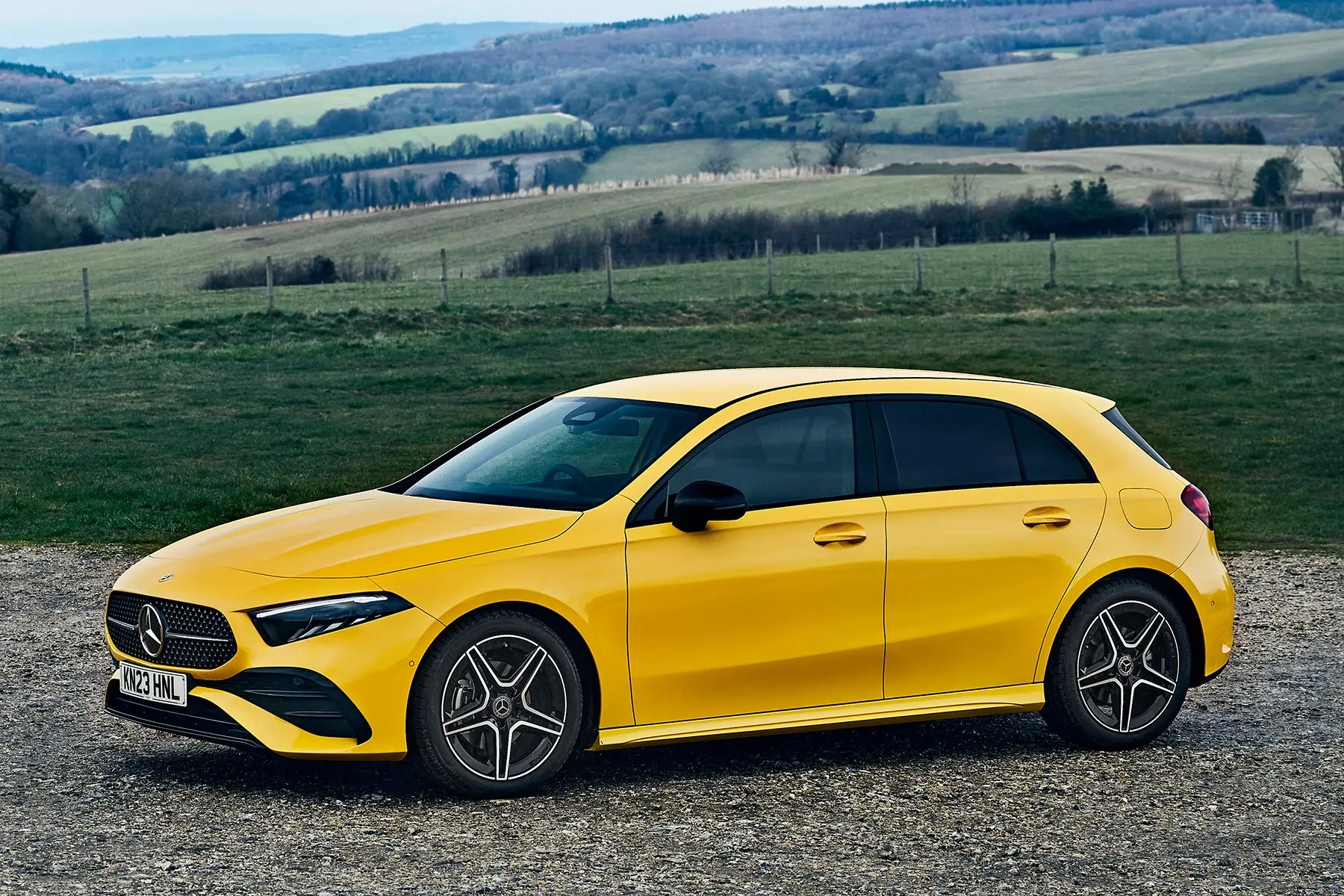
According to official lab figures, the Mercedes A250e is the top performer, returning up to 282mpg. That depends on you plugging it in regularly and rarely exceeding its 44-mile all-electric range, though. If you do that, it will be very efficient, but you might be even better off looking at a pure-electric alternative.
The Mercedes A200d ought to be very frugal with little effort, returning up to 57.7mpg in official tests. Diesels aren't suited to short journeys or around-town driving, though, so we'd only recommend one if you cover at least 12,000 miles a year.
The petrol A180 and A200 models now have a small degree of electrical assistance (dubbed 'mild-hybrid'), which allows them to return up to 47.9mpg. You won't be able to travel under electric power alone, but they ought to be fairly efficient in the real world.
How reliable is the Mercedes-Benz A-Class?
Mercedes put in a pretty middle-of-the-road showing in the latest HonestJohn.co.uk Satisfaction Index, but slightly alarmingly in this area, the reliability aspect of the research saw the brand perform poorly, being named as the sixth least reliable carmaker out of the 29 considered, although this was mainly down to the GLC and C-Class. We've heard a few reports of issues with the latest A-Class, particularly with the digital screens playing up on early models. There are no major common faults to be weary of, though, and we expect the A-Class should be a fairly dependable long-term ownership proposition.
Insurance groups and costs
If you're looking for a cheap Mercedes to insure, the A-Class should be a good purchase. The petrol A180 is likely to be the best choice for young drivers as its limited power output means it starts in insurance group 19, roughly the same as an equivalent Volkswagen Golf. Diesels will cost a little more to insure, as will the plug-in hybrids. Shop around for insurance quotes, though, especially if you have a few points on your licence.
VED car tax: What is the annual road tax on a Mercedes-Benz A-Class?
To avoid being stung with a hefty annual bill, it's worth checking if the A-Class you're considering had a list price of more than £40,000 when new. High-spec models do edge over this threshold, meaning owners are liable for the 'premium car tax', which amounts to an additional £390 a year for five years from the second time the car is taxed.
Otherwise, the regular VED bill for the Mercedes A-Class is £190, or £180 for those with some form of electrification (including mild-hybrid and plug-in hybrid models). That's the same as rivals - if you're looking for free road tax, you'll need to buy a pure-electric alternative like the Volkswagen ID.3 (and even that will be taxed within the next few years).
How much should you be paying for a used Mercedes-Benz A-Class?
"A new Mercedes A-Class today starts from more than £30,000, which makes it one of the most expensive family hatchbacks you can buy. That's partly because there isn't a no-frills entry-level model, though; even the cheapest Mercedes A-Class is well equipped and looks pretty smart."
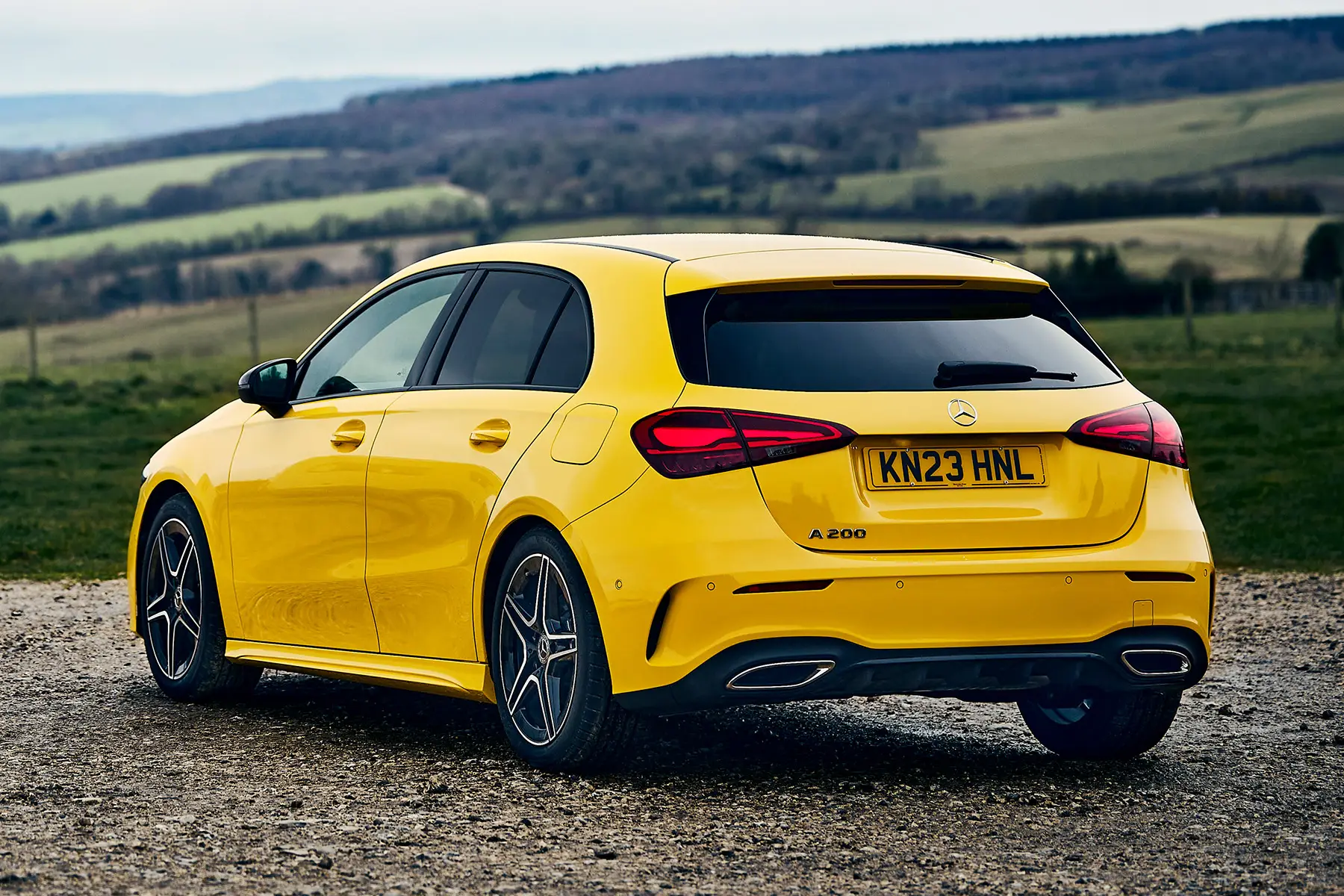
The good news for secondhand car buyers is that a few years' depreciation will soon slash thousands off the asking price. And, although the Mercedes A-Class has recently been updated, it's barely distinguishable from the original 2018 model, so there's no need to stretch the budget for the latest car.
A budget of around £14,500 will get you an early Mercedes A180d on heycar, and these are available in a variety of trim levels. There are also A180 petrols around at this money, and even a few A200s with higher mileages. If you're after a plug-in hybrid variant, you'll be looking at more like £18,000 or £19,000.
As is often the case in the current market, you won't save a great deal of cash by shopping for an as-new pre-registered model. That said, there are ex-demonstrator cars available at our trusted dealers, giving you a way to skip the waiting list and drive away in a new A-Class within a matter of days.
Trim levels and standard equipment
When the latest Mercedes A-Class first hit the market in 2018 it was available in a range of trim levels, namely: SE, Sport, AMG Line and AMG Line Premium. All were well-equipped and, while many buyers prefer higher-spec models for their sporty looks, there's little wrong with an early Mercedes A-Class SE.
Following the 2023 facelift, the range consists of Sport Executive, AMG Line Executive, AMG Line Premium and AMG Line Premium Plus models, as well as an Exclusive Launch Edition trim to mark the introduction of the facelifted A-Class.
Standard kit on the Mercedes A-Class Sport Executive includes 17-inch alloy wheels, LED headlights with adaptive high beam assist, privacy glass and the mirror package (with electrically-folding door mirrors and automatically-dimming rear-view mirror). Inside, the Sport Executive comes with 64-colour ambient lighting, heated front seats, a folding armrest in the rear, a leather-covered sports steering wheel, climate control and Artico man-made leather seats. There's also a 10.25-inch digital instrument cluster, a 10.25-inch infotainment display, wireless phone charging, Apple CarPlay and Android Auto as well as a reversing camera.
The Mercedes A-Class AMG Line Executive adds 18-inch alloy wheels and AMG bodystyling. Inside, the AMG Line Executive comes with sports seats in Artico leather/black microfibre with contrasting red stitching. AMG floor mats are standard, as well as a nappa leather sports steering wheel and brushed stainless-steel sports pedals.
Standard equipment on the Mercedes A-Class AMG Line Premium includes illuminated door sills, two-zone climate control, MBUX augmented reality navigation, a 10-speaker sound system, Exit Warning Assist and Blind Spot Assist.
The Mercedes A-Class AMG Line Premium Plus features 19-inch alloy wheels, multibeam LED headlights with adaptive high beam assist plus and a panoramic sliding sunroof. Inside, standard equipment includes the memory package (with an electrically adjustable driver's seat with memory function), a head-up display, MBUX interior assistant and a 360-degree parking camera.
The Mercedes A-Class Exclusive Launch Edition builds on the AMG Line Premium Plus specification with 19-inch alloy wheels painted black as well as the night package.
Ask the heycar experts: common questions
Is the Mercedes A-Class a good car?
What engine size is the Mercedes-Benz A-Class A200?
Which is the best Mercedes-Benz A-Class?
Stay up to speed with great offers plus the latest car news and reviews
Keep me updated by email with the latest advice, news and offers from heycar.
By submitting you agree to our privacy policy

